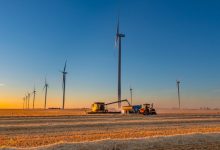Renewable energy development company RES and global investment bank Macquarie Group have sealed the finance and a buyer for the second stage of the huge Murra Warra wind project in Victoria, which will now begin construction to meet its power supply contract with the government-owned Snowy Hydro.
RES and Macquarie’s Green Investment Group (once known as the UK’s green bank) said the 209MW second stage of the Murra Warra wind farm has been sold to global private equity firm Parters Group, which already owns the 220MW first stage of the facility in western Victoria near Horsham.
Partners Group will pay $A180 million for the second stage, adding to the $A200 million it paid for the first stage in 2018. GE has been contracted to supply the 38 turbines, which at 5.5MW each will be the biggest in Australia to date, and Zenviron will build the project. RES – the biggest independent renewable energy company in the world – has the asset management contract.
Debt financing was provided by a consortium of international banks – ICBC, ING, Mizuho, MUFG, SMBC and Société Générale – but no Australian financial institutions.
It is understood to be the first time a project finance green loan has been used to fund the construction of a wind farm in Australia. The financing was raised in accordance with the Asia Pacific Loan Market Association’s Green Loan Principles, and subject to an independent Second Party Opinion from Sustainalytics.
The first stage of Murra Warra – which began production in April, 2019 – featured a then unique deal to sell its power under long term contracts to a consortium of corporate buyers, in this case led by telecommunications giant Telstra, and also including ANZ, Coca Cola Amatil and the University of Melbourne, as well as Monash University.
The second stage – due to be complete in March, 2022, is contracted to Snowy Hydro, one of eight wind and solar contracts signed up by Snowy in 2019 at what it said at the time were record low prices, delivering wind power in the range of $40/MWh and “firm” power i.e. wind and solar backed by dispatchable generation at a significantly lower price than prevailing coal and gas offerings.
However, Murra Warra was also been caught up in the problems facing wind turbine manufacturer Senvion, the supplier of turbines for the first stage, but which collapsed and led to then contractor Downer Group suffering a $45 million loss as a result of delays and complications to the project.
Murra Wurra has also been affected by some of the grid congestion in that part of the grid, and is located on the so-called “rhombus of regret” – named for the shape of the local network and the many constraints imposed by the market operator to ensure grid security.
It was required to install a large “synchronous condenser” to help manage frequency diversions and avoid the worst of the constraints imposed by the market operator. Many other wind and solar farms have been forced to make similar investments, although there is no evidence to date that any have actually been used.
GE supplied that sync on and says Murra Warra will be the second wind project – along with Bango in NSW – to feature its new Cypress onshore wind platform, which features a two-piece bead design that allows for longer blades, easier logistics, significantly increased energy output, increased efficiency in operations, and lower costs.
Murra Warra was Macquarie’s first big investment in the wind industry and Lachlan Creswell, the head of Macquarie’s Green Investment Group in Australia and New Zealand said it had focused on arranging equity, debt and the power purchase agreement, and highlighted the complimentary partnership with RES to deliver a significant and sustainable renewable energy project for Victoria.
“The completion of Stage I of the Murra Warra Wind Farm, and the development to construction of Murra Warra II marks a significant milestone for Australia’s renewable energy future,” he said in a statement.
RES has a portfolio of nearly 1GW in Australia and operates and manages more than 6GW globally. It has more than 60 staff in its Melbourne and Sydney offices and regional locations. “We are delighted to be able to continue our long-term involvement with the Murra Warra II wind farm and the local community through our construction management and asset management services,” CEO Matt Rebbeck said in the statement.
RES and Macquarie said 400 full time jobs will be created during the two-year construction period. The direct economic stimulus provided by the first stage of Murra Warra was $4.4 million to the local and regional economy through spending on accommodation, retail items and services and this local stimulus is anticipated to be replicated by the Murra Warra II construction.
A locally managed community fund for both projects will inject an additional $4m of investment into local projects over the lifetime of the wind farms.










